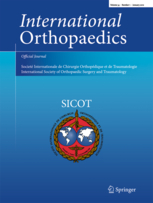
SPINE
Addition of intermediate screws to percutaneous pedicle screws for thoracolumbar fractures
Int Orthop. 2016 Jun;40(6):1103-1032 patients with a thoracolumbar fracture were randomized to receive either percutaneous short-segmental pedicle screw fixation with intermediate screws or percutaneous bilateral pedicle screw fixation without intermediate screws. The purpose of this study was to compare the two techniques in terms of operative time, estimated blood loss, postoperative back pain and function, sagittal Cobb angle, vertebrae body index, anterior vertebrae body height, and complications. Outcomes were assessed up to one year postoperatively. After one year, clinical outcomes of pain and disability did not significantly differ between groups, nor did correction or loss of correction of Cobb's angle. In contrast, there was greater correction, and significantly lower loss of correction over follow-up, of the anterior vertebrae body height and vertebral body index in the intermediate screw group compared to the control group.
Unlock the full ACE Report
You have access to {0} free articles per month.Click below to unlock and view this {1}
Unlock NowCritical appraisals of the latest, high-impact randomized controlled trials and systematic reviews in orthopaedics
Access to OrthoEvidence podcast content, including collaborations with the Journal of Bone and Joint Surgery, interviews with internationally recognized surgeons, and roundtable discussions on orthopaedic news and topics
Subscription to The Pulse, a twice-weekly evidence-based newsletter designed to help you make better clinical decisions
Exclusive access to original content articles, including in-house systematic reviews, and articles on health research methods and hot orthopaedic topics
Or upgrade today and gain access to all OrthoEvidence content for just $1.99 per week.
Already have an account? Log in


Subscribe to "The Pulse"
Evidence-Based Orthopaedics direct to your inbox.
{0} of {1} free articles
Become an OrthoEvidence Premium Member. Expand your perspective with high-quality evidence.
Upgrade Now












































































